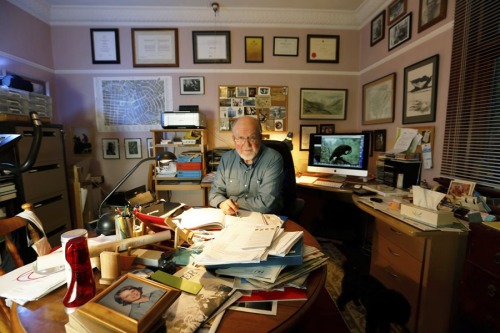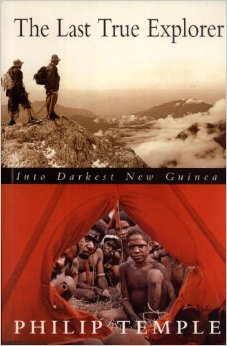The first ascent of the Carstensz Pyramid was made on February 13, 1962 by New Zealand mountaineer Philip Temple (22), Austrian Heinrich Harrer (49) of Seven Years in Tibet fame, Australian rock climber Russell Kippax (30), and Dutch patrol officer Bert Huizenga (25).
Being a bit of a budding historian, adventurer and author myself, I was most pleased to encounter Philip this past month (Sept 2013). He graciously agreed to guest write for this blog, sharing his summit experience as documented in The Last True Explorer (2002). He sent some fantastic photos to boot. Thanks so much to Philip for sharing this dynamic account, which ought to be especially engaging for anyone who has struggled to navigate that summit ridge in less than optimal weather. Enjoy, and read more about Philip here.

Philip Temple, adventurer & author, first ascentionist of Puncak Jaya, in his New Zealand office. Photo by Maja Moritz from http://www.philiptemple.com.
Tuesday, 13 February:
‘When the alarm rang at 3.30 a.m. I got up without wondering whether the sky was clear or not: something seemed to say – today is the day. The preparations of the evening before had been full and complete with an air of finality about them. As it turned out, the sky was clear with a spread of stars …’
We left camp at 5 a.m. using headlamps and torches to light our way across the Merendal, Middenkam and Geledal to the foot of the north face. Any feelings of anticipation and excitement were swamped by apprehension. Would I be good enough for this? My skills and experience were mostly on snow and ice in the Southern Alps; I had little technical rock-climbing ability and this was the first big rock face I had attempted. At the foot of the face it had grown light enough for us to stash our lamps at the 1936 campsite. Harrer had decided that I would lead the climb, carrying all the hardware of pitons, karabiners, hammer, etrier etc… plus one of the two light ice axes for the snow we might encounter on the ridge. I would take Huizenga on my 100-foot rope and, from the look on his face as he stared up at the wall, I was reassured that at least there was someone in the party more nervous than I. Kippax, the most skilled rock-climber in the party, would guide Harrer and carry his movie camera and film.

Philip Temple writing a note to leave in a cairn at the then snout of the Carstensz Glacier (now gone).
The start of our route followed a wide crack in the limestone wall, which laid back about ten degrees from the perpendicular. The first problem was a jammed boulder. Harrer below told Huizenga to watch all my moves carefully so that he could follow them: ‘He will probably come out of the crack now and go round the boulder’. But I somehow managed to pull myself directly over the top of the boulder and haul Huizenga up behind me. The crack now widened to a gully with vertical side walls which, another rope-length on, was blocked by an overhang. I was unable to cope with this and, trying to disguise my humiliation, I waited for Kippax to come up. With calm grace he climbed a 15-foot slab to a ledge that led above the overhang. I tossed him a piton and the rest of us hauled ourselves up on the attached rope.
I was able to cope with the cracks, steps and exposed ribs that lay above and moved rapidly from belay point to belay point to secure Huizenga’s ascent. A ledge led to the first prominent verschneidung or dièdre with easier, exhilarating climbing: ‘I yodelled happily as the sun warmed me and I swarmed up. There were about two rope-lengths to its top and Huizenga came up quite easily though always out of breath and often exhausted by the time he reached me’. This was probably from nervous tension as much as physical effort. ‘I avoided thinking about it but I was climbing worse than solo’. I had no belay from him, had to give him instruction and ensure his safety and there was ‘always the danger he might pull me off’. Although Huizenga often needed a tight rope, and a pull to get him over the difficult sections, he did well in nailed boots and ‘slipped only once all day’.
A horizontal shelf gave relief before a second and more difficult verschneidung and crack gave access to a wide shelf that had once, |centuries before, supported a hanging glacier. I was wearing leather gloves by now to protect my hands from the ‘needle-like, lacerating’ surface of much of the karst-weathered limestone. From the shelf, we walked into a snow-filled gully and ramp that took us to the crest of the west ridge after three hours of climbing. There was no view as the first cold mists of the day swirled up to engulf us.
A six-foot wide gap in the ridge proved our first obstacle; Kippax and Huizenga elected to jump, Harrer and I chose to use the etrier for a more circumspect climb in and out of the jagged fissure. As I retrieved it, Harrer and Kippax moved ahead into the mist and they were well out of sight when Huizenga and I arrived at the second break in the ridge, one so large that we had identified it as one of the cruxes of the climb. The ridge dropped vertically for about 40 feet to a snow shelf and then another 20 to the upper snow limit of the south wall hanging glacier. ‘A yell came out of the fog: “Two short abseils Phil!” I looked at Huizenga. Hell!’ What a place and time for climbing instruction. It began to snow.
I threw a sling over a rock outcrop, hammering away the karst spikes that threatened to cut it clean through, passed the climbing rope through it and then demonstrated to Huizenga how to wrap the rope around his body and lower himself down. Awkward but secure, he somehow slid down behind me and we climbed along an easy shelf to find Harrer and Kippax in a cave, stamping their feet. Single-pair-of-socks Harrer was no doubt feeling the cold in his frost-sensitive toes and for Kippax this was a long miserable way from the sun-baked sandstone crags of Sydney. They pointed to icicles that framed a hole through the ridge.
Harrer indicated that I should continue leading the climb. He needed someone to star in his movie (one that I would never get to see), so I tried to “look skilled and heroic” as I continued to find a way along the snow, scree and rock shelves of the south face, avoiding the massive pinnacle on the west ridge that we had christened ‘Fog Tower’. I became increasingly anxious about the time; it was now midday and the snow continued to fall. If the temperature dropped any more, we would have great difficulty negotiating a safe descent over a snow-plastered north face.
There was still nothing to be seen in the dense cloud when I regained the ridge and moved quickly along, only to be brought up short by yet another major gap which lay at the foot of what we judged was probably the summit buttress. A giant rock flake was wedged in the neck of an almost vertical rock couloir that dropped away into the cloud. The opposite wall was layered with a leering tongue of unstable snow. With minimal security from Huizenga, I climbed into the couloir, manouvred under the flake and, after detaching my ice axe from my back pack, stretched out for a footing in the snow. When I drove in the axe, its spike clanged against the rock beneath and I realised that it might break away under my weight. I packed down each step with great care – heart pounding – and half-slid upwards to reduce the pressure. Just as I reached a handhold of rock, half the snow below me collapsed and cascaded down the face. Understandably, Huizenga would not follow me and, with belays from both sides of the couloir, he crabbed directly over the flake. Harrer followed him and gave me a secure belay from which I could climb a rock slab and then another unstable slope of snow.
Rock, snow, ledge, rib, the ridge seemed endless and, after eight hours of almost continuous climbing, my energy began to fade. But neither fatigue nor diminishing time would stop me now. The ridge lifted and narrowed into a smooth snow peak but when I reached the top of this, I looked beyond to yet another rock pinnacle, convinced it must be higher. The others came up and laughed at my anxiety about which was the real summit. We could see no more than 20 or 30 yards into the cloud but one thing was certain. Beyond here the ridge trended down. We shook hands and I grabbed Harrer’s head in a mixture of exhaustion and exultation.
It was ten past two. We had made it just in time, for it would be too dark to climb after the onset of the long tropical night at seven. We carried no bivouac gear and we barely had enough time to get down. Quickly we took photographs sporting all the national flags – of Austria, Australia, New Zealand, Holland and ill-fated West Papua. We built a cairn and I left my small New Zealand pennant in a cigarette tin with names, times, date and the facetious comment, ‘I’m buggered’, echoing the phrase immortalised in New Zealand rugby history when All Black forward Peter Jones was asked how he felt after scoring the try that had won the test and the series against the Springboks six years before. What else should one leave at the top of a mountain?



